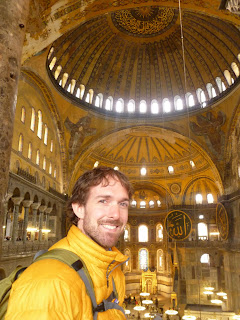Since arriving in Istanbul yesterday morning, we have been in full-on tourist mode. Let me re-phrase that: we have been basking in every minute of glorious tourist ecstasy. Istanbul is a feast for the eyes. European style meets classical beauty. The skyline is dominated by the minarets and domes of mosques, each one ornate and breathtaking in its beauty. Indeed, the history of Istanbul sheds some light on how the magnificent collision of cultures has shaped this striking city. As the gateway between Europe and Asia, Istanbul was for many centuries the capital of the Christian Roman Empire beginning with Constantine. More recently, it was the seat of the Muslim Ottoman Empire. In between, the city changed hands multiple times during the Crusades of the middle ages. Pre-dating all of that, modern day Turkey contains within its borders the remnants of many ancient cultures going back several centuries B.C. There is no shortage of interesting sites to behold and we have been endeavoring to behold them all.
 |
| 1st Turkish Coffee!! |
Next came the Blue Mosque. The Sultanahmet as it is called is also the name of the old part of the city where we have been staying. It is truly a magnificent structure with its 7 minarets projecting skyward from the many domes that comprise the main structure. Tourists are ushered through a side door during non-prayer hours, where we respectfully placed our shoes into plastic bags and Jo covered her long curly locks beneath her newly acquired turkish scarf. Once inside we gazed up at the ornate blue tiles of the domes (from which the Mosque derives its name). I'll let the pictures speak for themselves. What the pictures can't communicate however was the peaceful, serene feel of standing in this beautiful place of worship.

After regrouping and checking into our hostel, we made our way for the Topkapi Palace and the Istanbul Museum of Archeology. The museum houses relics from the earliest civilizations of Mesopotamia as well as most of the other significant settlements and empires that have occupied the middle east over the ages. It was as amazing to see the ancient cuneiform tablets as it was to see the ornate carvings that adorn the sarcophagi of Ancient Greece and Rome. Jo was like a kid in a candy store and I could barely keep up with her as she joyfully floated from room to room. As we poured over every informative sign and listened to each narrative on our audio tour, we were continually awed by the creativity, patience and craftmanship required to create the works of art upon which we gazed.

At this point, we were properly exhausted. After a quick dinner we returned to our bunks at the Mavi Guesthouse for a much needed night's sleep. Day two promised to be an eventful one and we wanted to be ready.
After breakfast, we headed for the Hagia Sophia, or Church of Holy Wisdom. It was originally constructed in the mid 4th Century A.D.by the Roman Emperor. The original church burnt down a hundred years later. However, in an amazing feet, the Church was rebuilt under Emperor Justinian in something like 6 years and for centuries it stood as one of the grandest churches in Christiandom. To think that it was built in a little more than 6 years is astounding after taking in the vast size and magnificent architectural design. As well, the walls and ceilings of the original church were covered with intricate mosaics depicting various biblical scenes.
After the Christians were driven from Constantinople (soon to be Istanbul) after the 4th Crusade, the church was converted into a grand mosque. This involved some beautiful additions such as the construction of minarets and the addition of Islamic art and symbols. It also involved the plastering over of the mosaics. In the early 20th century, under the order of Ataturk, the founder of modern Turkey, the site was declared a museum and excavations and restorations were undertaken. As it stands now, the museum is a unique and striking monument to both the Christian and Muslim faiths as the art and architecture of both traditions weave together in an intriguing tapestry. The highlight for us was viewing the partially uncovered and restored mosaics peeking out from behind the plaster that covered them for so many centuries. Jo was pretty taken with the Loge of the Empress as well ;)
After a much needed, late lunch, we ventured over the bridge to the neighborhood of Beyaglu, which comprises what is considered to be the "New City". We made our way through a wide street crowded with Turks and Tourists alike to Taksim Square where a statue celebrates Ataturk and the establishment of modern day Turkey. Along the way we took in the sights and sounds. A highlight was a fantastic street band of four playing beautiful, tribal yet melodic music on a drum, a didgeridoo-like instrument, a guitar and another stringed instrument that slightly resembled a hammer dulcimer, but sounded hauntingly eastern. After shaking it for a while and shooting some video, I concluded that these guys would definitely be on the summer festival circuit if they made their way to the U.S.
All in all, two very full and satisfying days. Soon, we will catch a flight down to the Mediterranean Coast where we will spend some time in a tree house and take in the beach and the ruins that supposedly abound in that region. I've said it before, I'll say it again: we feel so grateful to have this opportunity.



















































